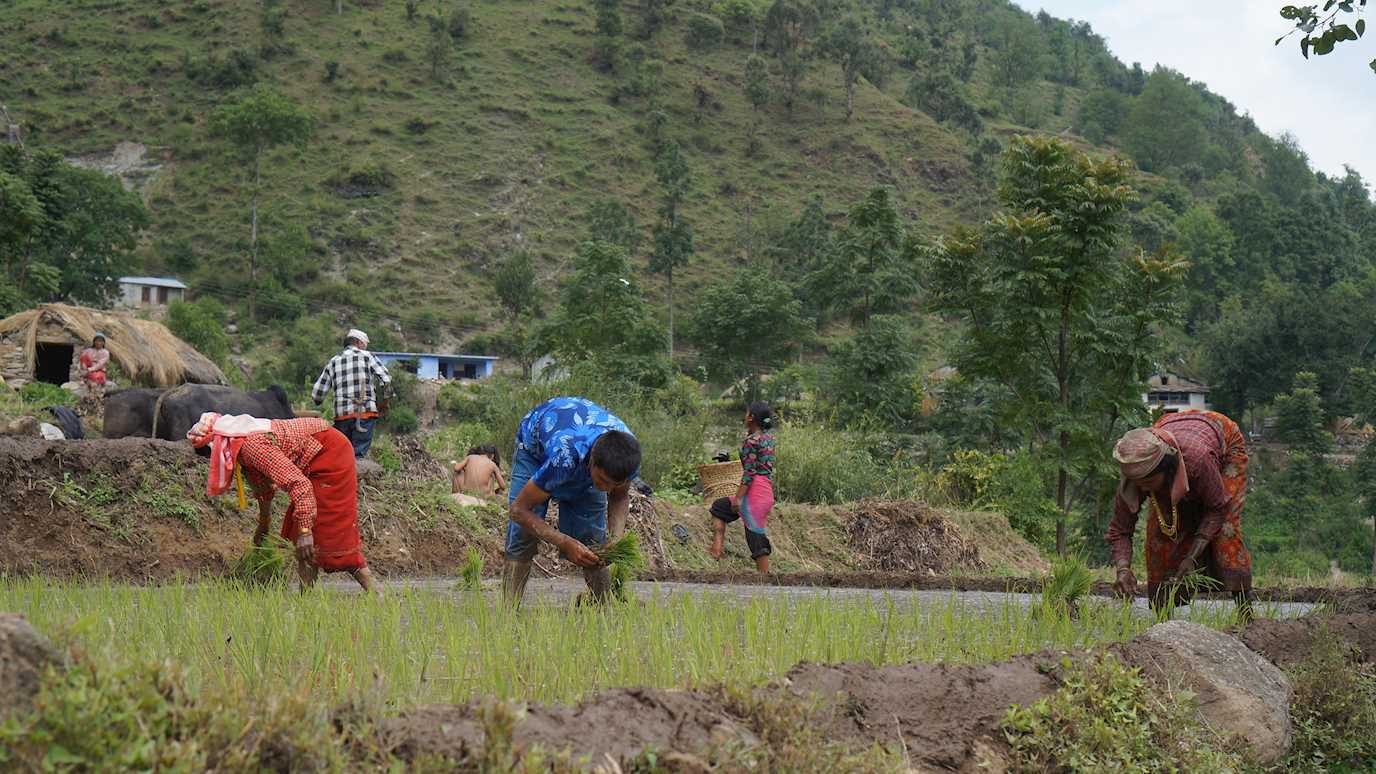Global food insecurity is high and has increased over the last five years. There is not much to celebrate on this World Food Day. Now might, however, be a good opportunity to introduce changes into the global food system that would increase its long-term sustainability and resilience, namely more widespread adoption of climate-resilient cereal crops, agroecological farming methods, and vertical farming.

Photo by Jui Shrestha
State of food security in the world right now
Food security rests on four pillars – food availability, access, utilisation, and stability. Availability relates to the amount of food present in a country, either through production or imports, whilst access refers to households’ and individuals’ ability to obtain food, whether by producing, buying, or receiving it as a donation. Utilisation concerns the body’s usage of macro- and micronutrients from food in its functioning and stability relates to reasonable certainty about future food availability and access. All four pillars have appreciably deteriorated in recent years.
Food availability
Global agriculture produces enough food to feed everyone. However, food production faces adverse challenges from climate change and environmental degradation. According to a recent study, climate change is already reducing global rice yields by 0.3% and wheat yields by 0.9% per year. These adverse effects are expected to accelerate with rising temperatures and widen the disparity in production between higher-income and lower-income countries. The negative effects of climate change on food production were very evident across the globe this year. Droughts and heatwaves in India, China, Europe, and North America impaired wheat, rice, maize, and vegetable harvests; in Pakistan, historically unprecedent flooding decimated most of the country’s crops. The war in Ukraine has also hindered food production, not only by impeding Ukraine’s own agricultural activity but by triggering a precipitous rise in global energy and fertiliser prices.
Access to food
The damaged harvests, economic hardship, and high food prices have contributed to an increase in the global prevalence of people without access to sufficient food, from 7.6% in 2017 to 9.8% in 2021. In Africa this year, every fifth person is estimated to be undernourished. Areas most affected by hunger include countries in the Horn of Africa, particularly Somalia, Ethiopia, and Kenya, the Democratic Republic of Congo, Yemen, and Afghanistan. In Somalia’s Bay region, food insecurity is so high that famine conditions are anticipated to emerge between October and December 2022 and food aid is urgently needed to mitigate the loss of life.
Food utilisation
Food utilisation, connected with health and quality of the food consumed, is usually measured through people’s nutrition outcomes. Up until recently, these were steadily improving. For example, stunting amongst children under five years old decreased globally from 33% in 2000 to 22% in 2020. However, the Covid-19 pandemic and the subsequent economic, financial, and energy crises have put a stop to this positive trend. This happened in different ways, from an increase in children’s consumption of high-calorie snacks during lockdowns in richer countries to interruptions in the provision of free school meals and the closure of infant-feeding and monitoring programmes in lower-income countries. In many of the poorest countries, these negative effects are compounded further as their governments cut health spending in an effort to balance their budgets.
Stability
Global food prices are currently high – in September 2022 5.5% higher than the year before – but have climbed down from the 2022 peak following the outbreak of the war in Ukraine in February. They are, however, still about 40% higher than global food prices in 2019, before the pandemic. This has translated into 10% to 30% rates of domestic food-price inflation in most countries and undermined the predictability of the food systems.
Remedies
Despite the disheartening state of current global food security, there are actions that countries can take now to make food systems more sustainable and resilient. These include the adoption of underutilised grains, of agroecological practices, and of vertical farming where appropriate.
Wider adoption of climate-resistant crops
Over the past half century, global diets have become increasingly homogeneous, with 50 major crops – wheat and rice in the top five - accounting for 90% of all consumed calories. The reliance on a small number of crops has made agriculture more vulnerable to pests, plant-borne diseases, and soil erosion. Because research and development on the major crops occurs largely in high-income countries, most of which also have in place significant agricultural subsidies, many lower-income countries over time reduced their domestic food production. Just in the past decade, Africa’s food imports tripled in value. In Senegal, for example, wheat consumption grew from 16 kg per capita per year in 1960 to 42 kg in 2021, even though wheat cannot be cultivated in the country due to unfavourable climate conditions. This happened also thanks to the EU’s agricultural subsidies, which have made European wheat flour cheaper than the millet flour produced in Senegal.
But the high global food prices are leading many lower-income countries to consider reembracing traditional cereal crops like millet, which can be cultivated domestically and are both more climate-resilient and nutritionally superior. India’s national food-subsidy programme, the Public Distribution System, encouraged farmers since the 1960s to grow primarily wheat and rice. However, as water insecurity spreads across the country, there has been a push to reorient the subsidy towards millets, which are more drought resistant and higher in fibre and essential minerals than wheat or rice. Meanwhile, the recent increase in global wheat prices has made millet flour more competitive in Senegal, where bakeries have been incentivised by the government to incorporate millets in bread flour. Other drought-tolerant and nutritious crops that could help boost food and nutrition security in lower-income countries include amaranth, fonio, sorghum, cowpeas, and taro.
Embracing agroecological practices
Another important advantage of traditional crops such as millet or fonio is that they require fewer chemical interventions – fertiliser and pesticides – to grow than dominant cereal crops like rice or wheat. They are thus suitable crops for inclusion in agroecological approaches, also referred to as regenerative agriculture. This low-external-input organic farming relies on practices such as mulching, propagating local seed varieties, crop rotation, and water conservation. Agroecology further aims to improve biodiversity and stimulate interactions between different species to build long-term soil fertility and healthy agroecosystems. The agricultural approach is more sustainable in the long run than traditional agriculture as it has a lower ecological footprint, is more resilient to climate change, and less susceptible to volatility in global agricultural input prices. Moreover, as Turba, a regenerative farm in Lebanon, demonstrates, the agroecological cultivation is not only shielded from the negative effects of the recent trebling of global chemical fertiliser prices but also three times more productive than neighbouring conventional farms. If adopted more widely, agroecological farming could thus boost both food security and resilience in lower-income countries – as the case of Cuba in the 1990s illustrated.
Vertical farming
Vertical controlled-environment crop cultivation is seen as the most climate-resilient farming method, as it is not susceptible to changes in outside temperature or rainfall patterns. Vertical farming also claims to be more efficient in the use of natural resources, with a smaller land footprint and up to 95% water conservation compared to conventional farming. It furthermore protects crops from pests, minimising the use of pesticides, and lowers fertiliser use. However, the farming method is highly energy-intensive, which poses currently the largest challenge to its wider rollout. The associated carbon footprint can be highly reduced by using renewable energy, which, however, has large land requirements. With current technologies, vertical farming is superior to conventional or greenhouse farming only in the cultivation of high-value leafy crops like lettuce or in extreme climates with abundant wind or solar energy potential such as Iceland or the United Arab Emirates. However, it is likely that with more efficient renewable energy technology and more adverse climate conditions in the future, vertical farming could become not only a more resilient but also a more sustainable agricultural approach than conventional farming, particularly in urban and water-insecure areas.
Last thoughts
To sum up, the current state of global food security is not encouraging. However, the multiple crises occurring right now could encourage a wider transition to practices that would make local food systems more sustainable and more resilient, namely growing more locally suitable crops, using agroecological approaches, and deploying vertical farming where suitable. These adoptions could not only help boost local food availability but also local food access, utilisation, and stability, improving food security holistically and in places where it is needed the most.
Dr Ivica Petrikova is a Senior Lecturer in International Relations at Royal Holloway. Ivica's research ranges from aid effectiveness through food security, poverty reduction, and agricultural policies to economic inequality and social capital.
























